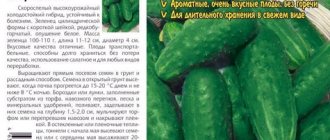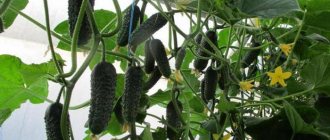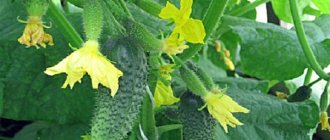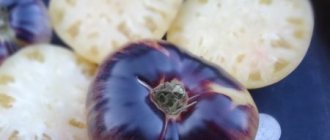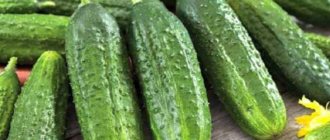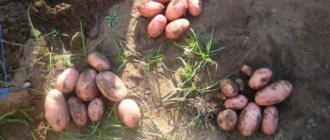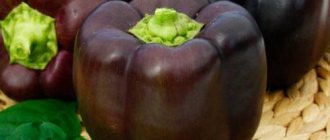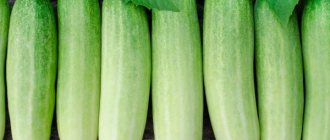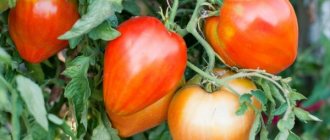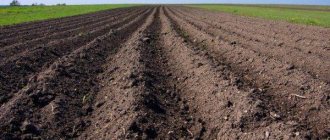Description of the variety
Hybrid Bjorn F1 is parthenocapic, or self-pollinating. It does not need insects for pollination. Thanks to this property, the variety bears fruit well in greenhouses where there are few insects.
Cucumber Bjorn F1 is a slender plant with large green leaves and a powerful root system. It forms a compact open bush as its leaf cover is not too dense. The plant has short side shoots, which makes it easier to care for.
The hybrid produces cucumbers of the usual gherkin size - 10-12 cm. Cucumbers grow uniform, tasty, without bitterness. They are well suited for making salads, pickling and marinating.
Description of cucumbers
Hybrid Bjorn (aka Bjorn F1) is grown throughout the Russian Federation in closed ground conditions , where the crop produces two turns in one season (spring-summer and summer-autumn). In regions with a favorable climate, cucumbers are successfully grown in open beds.
The hybrid has high stress resistance and successfully withstands temperature changes, errors in watering and maintenance. The ovaries of plants develop quickly. They do not fall off due to temperature changes or insufficient lighting.
Distinctive features
Cucumber Bjorn F1 belongs to the indeterminate plant type . This is a parthenocarpic hybrid, that is, its fruits set without pollination. Weather conditions do not affect the development of ovaries. Cucumbers are grown both in open ground and in greenhouse conditions.
Composition properties, benefits, calorie content
Cucumber has a complex composition and includes many vitamins and microelements important for humans. The vegetable retains its beneficial properties even when pickled or canned. 100 g of product contains only 10-15 kcal, so if you eat even a kilogram of cucumbers, you will not gain excess weight.
Cucumber contains the following vitamins :
- vitamin A;
- vitamin B1;
- vitamin B2 (riboflavin);
- vitamin B3 (pantothenic acid);
- vitamin B6 (pyridoxine);
- vitamin B9 (folic acid);
- vitamin C;
- vitamin E (TE);
- vitamin K (phylloquinone);
- vitamin PP (niacin equivalent);
- beta-carotene;
- choline
also contain microelements such as :
- magnesium;
- selenium;
- copper;
- phosphorus;
- zinc;
- iron;
- calcium;
- potassium;
- sodium.
Cucumbers consist of 90-95% structured water. This product improves the functioning of the digestive system, thyroid gland , acts as a vasoconstrictor and a diuretic.
Vegetables contain alkaline salts that prevent the formation of sand and kidney stones . They also contain iodine compounds and fiber, which stimulate proper intestinal function.
On a note. Cucumbers slow down skin aging.
This product is considered absolutely dietary . It can be used with virtually no restrictions. Nutritionists recommend spending a fasting day on cucumbers, during which you can eat up to 1-1.5 kg of vegetables.
Characteristics
The culture is not limited in growth, the root system is well developed . The hybrid is characterized by weak climbing. The amount of foliage is average. The hybrid has a female type of flowering, there are no barren flowers. Each node contains from two to four ovaries, from which cucumbers are formed.
For your information. The hybrid does not undergo the stepson procedure. Also, plants do not require blinding of the lower leaf axils.
During the entire fruiting period, the shape and size of the fruit remain one-dimensional . Vegetables do not overgrow or turn yellow. Björn's type of cucumber is gherkin. Smooth greens have a cylindrical shape. The length of the vegetable is no more than 12 cm. The average weight of one fruit is 100 g.
Cucumbers have an attractive appearance.
There are no spots or light stripes on dark green vegetables .
The flesh is dense and crispy. There is absolutely no bitterness in vegetables. Bjorn F1 is one of the earliest cucumbers . The fruits ripen 35-40 days after sowing. The culture bears fruit within 60-70 days. Some vegetable growers grow the hybrid in greenhouses twice a season.
The Bjorn cucumber is popular due to its high yield . When growing vegetables in open ground from 1 sq. m, summer residents collect about 13 kg, in greenhouse conditions - 20 kg.
The fruits are universal in use . Cucumbers are used for preparing fresh salads and winter preservation. During transportation, they do not lose their external and taste characteristics.
Ripening time
Hybrid Bjorn F1 is one of the earliest varieties of cucumbers. The period from planting to harvest is from 35 to 39 days. This variety is a hybrid of the “Sprinter” type. He gives away the harvest within two to two and a half months.
In film greenhouses, the variety and in protected soil conditions, cucumbers can be grown in two rotations.
Features and advantages of the variety
Currently, gardeners use two methods of planting this plant: seed and seedlings.
Growing seedlings is more profitable, as it allows you to get a rich harvest. Before sowing, the seeds are stratified:
- The selected seed material is immersed in a weak solution of potassium permanganate for half an hour.
- then washed, dried and wrapped in a damp cloth. The seeds are stored in a moist environment until they are hatched.
- Germinated seeds are planted in seedling boxes with loose and slightly acidic soil.
- The best time for landing is mid-April.
During the growing process, seedlings are provided with stable heat - 23-25 degrees Celsius and regular soil moisture, and you should also consider:
- During this period it is very important to avoid drying out the soil. Therefore, the seedlings are placed in a room with a high level of humidity and good lighting.
- At noon, the plantations are shaded from direct sunlight. Planting of young plants in open ground or in soil under a film is carried out at the stage of appearance of 4-5 leaves.
- The planting pattern is 150x30 cm. The trellised cultivation method is used for this crop. The formation of shrubs during the growth process is not carried out.
- The plants themselves regulate the growth of side shoots. Fruiting begins from the first sinus.
An early-ripening parthenocarpic hybrid has become one of the most successful developments of Dutch selection. Positive reviews from domestic vegetable growers are proof of this.
- A distinctive feature of the new variety is the uniform germination of fruits and consistently high yields.
- This universal hybrid is bred for cultivation in greenhouses and open ground. The Bjorn cucumber variety is suitable for planting in regions with different climatic conditions.
- The bushes are powerful with underdeveloped side shoots. The ovaries are formed in the form of a bouquet. Up to 4-5 fruits can form in one sinus.
- The description of the variety includes early ripening of the crop. This is one of the few hybrids that produces the first harvest of greens 35-38 days after emergence.
- The fruits are dark green, smooth, with pimples covered with white spines. The length of one fruit is 10-12 cm, weight is about 100 g.
Fruits with hard, crispy and juicy pulp are widely used in cooking. They are added to salads, snacks, salted, pickled and canned.
The characteristics of the Bjorn f1 hybrid include several unique qualities that make this variety one of the elite:
- long-term storage of fruits without loss of presentation;
- possibility of transportation over long distances;
- excellent taste;
- shade tolerance;
- precocity;
- disease resistance;
- plants do not need pinching and shaping;
- consistently high productivity.
A summer resident’s dream is an early harvest of strong green cucumbers that can easily withstand adversity. If the variety of such cucumbers is not prone to overgrowing, its fruits have an excellent taste and are the same size, it immediately becomes a favorite. The described qualities are possessed by a new hybrid of the first generation - the Björn cucumber (“björn”, “born”).
Today there are many varieties of cucumbers on sale. Thanks to modern selection, new hybrids have the best qualities - disease resistance, early maturity and consistently high yields even in the most severe climatic conditions. Cucumber bjorn f1 is one of them. In our section we will provide a detailed description of the variety, its agricultural technology and cultivation features.
Planting and care
Cucumbers of the Bjorn F1 variety are grown in greenhouses and in open ground. Planting is done in two ways: directly into the ground and with seedlings. Pre-sowing seed treatment is not necessary.
Planting seeds directly into the ground
Cucumber seeds Bjorn F1 are planted in open ground when the frosts end and the ground warms up to a temperature of +13. There is no point in planting in cold soil, as the seeds will not sprout.
The best predecessors of cucumbers are lettuce, kale, peas, and green manure. You should not plant cucumbers where beans, carrots and zucchini used to grow, as these crops have diseases in common with them. Also, you should not grow cucumbers in the same place for more than five years.
Hybrids grow well in both sunny and shaded areas. But cucumbers are light-loving plants. If possible, they should be planted in sunny places. The beds are located from north to south.
Characteristic
Variety Bjorn F1 is a self-pollinating (parthenocarpic) hybrid. Insects do not have to take part in its pollination. Thanks to this property, it is ideal for growing in a greenhouse where there are no insects.
The plant is slender, tall, with large round leaves of a rich dark green color. Its bush is not very spreading, and the side shoots are not long, which greatly simplifies care. Another advantage is that this variety has fewer leaves than others, which allows the cucumbers to ripen faster.
Description of fruits
The vegetables are dark green with small pimples and have a uniform density. The average size of a cucumber is 9-12 cm (gherkin), the taste is pronounced, the vegetable is not bitter.
Productivity
The variety gives excellent results in terms of fruiting, which makes the yield of Bjorn F1 high. Most cucumbers are placed on the main stem, which makes harvesting the fruit easier. Flowering is of bouquet type - in each axil there are 4-5 ovaries, from which greens then grow.
The bush produces up to 15 kg of fruit per season. Another qualitative characteristic of the variety is that cucumbers do not barrel during the ripening process.
Ripening time
This cucumber variety is early (hybrid sprinter). From the moment the seedlings are placed in the ground until the first fruits appear, approximately 37-40 days pass. The harvest can be harvested in about 1.5 months.
Cucumbers can be harvested at the end of June - beginning of July. In well-equipped greenhouses with fertilized soil, this variety can be grown 2 times per season.
Application area
Fruits are universal in use
After the cucumbers reach the desired size, they are picked immediately so that they do not become overripe (otherwise their peel becomes rough and the texture becomes watery). You need to pick cucumbers every 2 days.
Variety Bjorn F1 is suitable for:
- pickling (cucumber size – 8-12 cm);
- canned food (up to 10 cm, small cucumbers are crispier);
- slicing for salads (from 10 cm).
Resistance to diseases and pests
The characteristics of the variety indicate the plant’s resistance to disease. Different types of powdery mildew, mosaic, spotting (cladosporiosis) or aphids have absolutely no effect on the development of the plant. The cucumber variety Bjorn has strong immunity to them.
But still, plants are exposed to some risks, so for prevention you need to spray the bushes with special protective agents: “Winner”, “Kultar”.
Landing region
Gardeners from different regions speak well of this variety as resistant to different climatic conditions. It is best grown in warm (southern and central) regions of the country. The yield level in such conditions will be the highest, and care will be minimal.
Planting seedlings
With the seedling method of planting, the yield is much greater. Cucumbers ripen two weeks earlier, and the fruiting period increases. If the seedlings are intended for planting in a greenhouse, then the seeds are planted in early April. For planting in open ground - in May.
Caring for cucumbers involves watering, loosening, weeding, and fertilizing. There is no need to pinch side shoots, remove shoots or form the main stem.
Cucumber beds need to be regularly cleared of weeds. After each watering or heavy rain, the cucumbers are loosened. Loosening is done carefully so as not to damage the plants.
Cucumbers need feeding. If they grow in a greenhouse, then fertilizing is done 5-6 times, if in open ground - 4-5. When feeding, alternate organic and mineral fertilizers.
Care
Cultivation of the variety in question will not cause any particular difficulties. Björn f1 needs regular but not too frequent watering, careful loosening after rainfall and frequent feeding. The cucumber practically does not need to form a bush, but it will require periodic weeding and inspection for parasites.
Watering
This cucumber is not watered as often as most other hybrids - once every 2-3 days, depending on the weather. The main thing is that the soil around the bushes of the variety does not dry out, but it is also extremely undesirable to allow “swamps” at the roots. Water Björn with lukewarm water, well-settled in sunlight. The plant does not tolerate strong, heavy streams - water the cucumber gradually, at the root, using the drip method.
The best time to water Bjorn f1 is in the evening, after sunset, when it gets cool. After each procedure, the soil at the roots must be loosened.
Garter and bush formation
Bjorn f1, judging by the description, is able to independently control lateral branching, so its bushes do not need complex formation. The variety does not require the formation of a plant into one central stem - this usually happens automatically. As the Bjorn sprouts reach 25-30 cm, they are tied to vertical trellises so that the leaves do not touch the ground. Finally, since this is an unlimited growth variety, the top of each Bjorn bush is pinched at a height of 1.5 m.
Top dressing
Cucumber needs frequent nutritional feeding - usually it alternates between mineral liquid mixtures and organic matter. Bjorn f1 is fertilized on average 6 times per season. The recommended feeding scheme is as follows:
- The first two feedings are mineral - as the 2nd and 4th leaves appear. Potassium nitrate, or potassium sulfate, is used for the variety.
- The next important stage is the beginning of flowering. During this period, the cucumber needs to be fed with organic matter - a solution of chicken droppings, or humus.
- Finally, the last stage is the beginning of fruiting. At this time, the variety is fertilized with superphosphate and urea solution - alternately.
Fertilizers are applied in a thin layer under the root of the hybrid Bjorn f1, every 10 days.
Hilling
The bushes of the variety are sprinkled with earth after every second watering. In cool, wet weather - after each watering or precipitation. Each Bjorn f1 plant is hilled to a height of 20 cm. The soil is poured onto the cucumber along with mulch scattered between the rows - hay, sawdust, or peat.
In addition to hilling, the variety also needs regular loosening - after each watering or rain. You need to loosen the cucumber carefully, shallowly, so as not to touch the roots located close to the surface. Weeding is also of particular importance - Bjorn is weeded once every 4-5 days, clearing the area even of small roots and debris caused by birds.
Sowing
Typically, planting in open ground is carried out at the end of May - the first ten days of June. It is not worth planting later, as cucumbers do not tolerate heat well in mid-summer.
Sowing is done with dry seeds. They are placed flat in the ground. Seeds are planted to a depth of 2-3 cm at the rate of 5-7 bushes per square meter. Dry soil is watered before planting, and the seeds are sprinkled with humus or soil mixed with sawdust.
Seeds of cucumbers are planted in a greenhouse or greenhouse from May 17-21. Before germination, crops are watered daily with warm water in the middle of the day. Later, water once every 1-2 days.
Planting seedlings
For planting, prepare peat pots and plant two seeds in each. The seeds are watered every day with warm water. Shoots appear on the fourth or fifth day. When 3-4 true leaves appear on the plants, that is, after two to three weeks, the seedlings are transplanted into greenhouses.
Hybrids are grown using a trellis method. The distance between rows should be at least 160 cm, and between plants 30-35 cm.
Cucumber Björn f1 – varietal characteristics and growing technology
Currently, gardeners use two methods of planting this plant: seed and seedlings.
Growing seedlings is more profitable, as it allows you to get a rich harvest. Before sowing, the seeds are stratified:
- The selected seed material is immersed in a weak solution of potassium permanganate for half an hour.
- then washed, dried and wrapped in a damp cloth. The seeds are stored in a moist environment until they are hatched.
- Germinated seeds are planted in seedling boxes with loose and slightly acidic soil.
- The best time for landing is mid-April.
During the growing process, seedlings are provided with stable heat - 23-25 degrees Celsius and regular soil moisture, and you should also consider:
- During this period it is very important to avoid drying out the soil. Therefore, the seedlings are placed in a room with a high level of humidity and good lighting.
- At noon, the plantations are shaded from direct sunlight. Planting of young plants in open ground or in soil under a film is carried out at the stage of appearance of 4-5 leaves.
- The planting pattern is 150x30 cm. The trellised cultivation method is used for this crop. The formation of shrubs during the growth process is not carried out.
- The plants themselves regulate the growth of side shoots. Fruiting begins from the first sinus.
This variety belongs to the Dutch selection. It is early ripening, characterized by high germination and good yield - up to 20 kg per 1 sq.m. The variety is universal - it can be grown both in open ground and in greenhouse conditions.
The bush itself is powerful, the side shoots are poorly developed, the roots are strong, the flowering type is a bunch. Up to 4 fruits can form on one axil. Early variety - growing season on average - 35 days.
The fruits are dark green, smooth, about 10 cm long, weighing on average about 100 g. The pulp is crispy, without bitterness, pleasant to the taste.
Directions for use: Suitable for both fresh consumption and canning.
Planting region - this hybrid is famous for its high stress resistance. He is not afraid of temperature changes or insufficient lighting. Therefore, it is suitable for cultivation in completely different climatic zones, but the most suitable are the southern regions and the Volga region.
The variety is highly valued by many vegetable growers for a number of undeniable advantages:
- high productivity;
- fruiting harmony;
- excellent taste properties;
- ease of care;
- is not afraid of a number of diseases (cladosporiosis, mosaic, etc.);
- stress resistance.
At the same time, the variety does not have any particular disadvantages.
The Bjorn variety has an indeterminate main stem, i.e. it is not limited in growth. Can reach 1.5-2 meters in length. The root system of the plant is powerful, so it does not require a large amount of bait. Slightly climbing variety with self-regulating branching. The leaf system is well developed, but the bush is not overloaded with leaves.
Note!
The side shoots are quite short with slow growth. The leaves are rich green, but not dark in color.
The type of ovary formation is bunched (bouquet), which ensures high yields of the variety. It is better to form a bush vertically, tying it to a trellis. The bushes are convenient not only during the process of formation, but also do not require close attention after harvesting (blinding the lower leaf axils, pinching).
- Gherkin type.
- They do not exceed 12 cm in length, weighing on average 100 grams.
- Maintain uniformity of shape and size throughout the entire fruiting period.
- They do not outgrow or overripe and retain their physical and taste qualities.
- The shape of Zelentsy is classic cylindrical.
The peel is dense, crispy, dark, rich green in color, there are no light stripes on the surface (uniform color). The pubescence is frequent and white. Large bumps can be seen on the surface.
The pulp has excellent taste, dense, slightly sweet in taste. Thanks to genetic characteristics, the fruits never become bitter (even if the watering regime is not followed or the harvest is untimely). According to their culinary purpose, cucumbers are a salad variety, i.e. recommended for fresh consumption. But experienced housewives note that greens do not lose their qualities when salted or pickled, which allows them to be used in home canning.
Planting on the ground (both open and greenhouse) can be done in two ways: seedlings and dry seed material. However, experienced gardeners and large farmers recommend the seedling method, explaining this by faster germination and high yields. The plant requires watering regularly and very abundantly.
- It is better to use organic substances and ready-made mineral mixtures.
- Such procedures are usually required 5-6 times per season.
The soil must be mulched with peat. Attention should be paid to the formation of bushes. From each plant you need to stretch a rope to the twine at a distance of 2 meters from the bed. A vertical method is required for cultivation.
When growing hybrid parthenocarpic cucumbers, many do not pay due attention to pinching. It is known that for non-hybrid varieties such a procedure is necessary to prevent the appearance of barren flowers on the bushes. For hybrids, pinching is done to control the growth of the plant and form a good bush. Pinching stimulates the formation of new ovaries, which increases yield.
The variety is early ripening, which, with good care, yields twice a season, so they need to be planted early. In May, as soon as periodic night frosts stop. The ambient temperature should reach 18 °C. When planting with dry seeds, after fertilizing and watering the soil, small depressions are made in the ground (approximately 2 cm).
Note!
The distance between the bushes can not be made too large, because The bushes are not very branched and the plant is resistant to lack of light.
The crop is harvested twice per season. You need to be careful when doing this:
- cut cucumbers without damaging the stem, otherwise it will dry out and stop bearing fruit;
- remove all ripened fruits from one bunch;
- do not leave fruits on the branch, harvest regularly once every 2-3 days, daily during the period of intense fruiting;
For the winter, cucumbers can be canned and frozen to be used fresh for culinary and cosmetic purposes. Cucumber masks perfectly nourish and moisturize the skin. They also relieve swelling and redness.
Cucumber is one of the most common vegetables, which today is found in many vegetable gardens, greenhouses, etc. The variety of cucumber varieties is pleasantly surprising and allows you to choose exactly the one that will look most organically on your site. Currently, one of the most common varieties is Bjorn F1.
Another development of Dutch selection, the early-ripening parthenocarpic (self-pollinating) hybrid Bjorn F1 is distinguished by excellent germination and very high yield - up to 20 kg per square meter in greenhouses and under film, and in open space no worse - 13-14 kg per 1 sq. m. Grows well both in greenhouse conditions and in the open air in regions with different climatic conditions.
The plant itself is very powerful, with underdeveloped side shoots, strong roots and a bouquet type of flowering. Up to 4 cucumbers can form on one bosom, and absolutely everything ripens! The variety can be said to be the earliest - the growing season is 35-39 days. And it grows so quickly - just have time to harvest!
Cucumbers are dark green in color, all smooth, 10-12 cm long, weighing 90-100 grams, with medium pimples covered with white spines with juicy, hard, crispy flesh without bitterness, excellent taste. Cucumbers of this hybrid have an unsurpassed taste - both in fresh salads and in homemade marinades they have no equal!
A summer resident’s dream is an early harvest of strong green cucumbers that can easily withstand adversity. If the variety of such cucumbers is not prone to overgrowing, its fruits have an excellent taste and are the same size, it immediately becomes a favorite. The described qualities are possessed by a new hybrid of the first generation - the Björn cucumber (“björn”, “born”).
Cucumber Bjorn F1 is one of the most popular hybrids among gardeners. It was bred by Dutch breeding, and a few years later it was already grown throughout Europe. Thanks to the optimal set of qualities, the vegetable grows well, is unpretentious to conditions, resistant to diseases and demonstrates excellent productivity.
The plant is slender, tall, with large round leaves of a rich dark green color. Its bush is not very spreading, and the side shoots are not long, which greatly simplifies care. Another advantage is that this variety has fewer leaves than others, which allows the cucumbers to ripen faster.
Description of fruits
The vegetables are dark green with small pimples and have a uniform density. The average size of a cucumber is 9-12 cm (gherkin), the taste is pronounced, the vegetable is not bitter.
Productivity
Pests and diseases
Cucumbers are often attacked by pests. They especially often settle in greenhouses.
- Whitefly is an insect 2mm long. She sucks the juice from the cucumbers. Insects usually congregate on the undersides of leaves. If they are not destroyed, the plant will wither and die.
- Aphid. These pests are highly voracious and prolific. Aphids suck the juice from cucumbers. Aphid colonies can cause severe damage to plants.
- Slugs. These pests come out at night and crawl on plants. They leave behind a slimy residue that harms the plants. Slugs are voracious creatures. They can destroy the entire cucumber crop.
- Putin ticks. They are often bred in greenhouses where it is warm and humid. Mites collect on the inner surface of leaves. They can be seen by the cobwebs on plants. Ticks suck the juice from the leaves. Marble spots appear on the leaves and they die.
To prevent pests from breeding, the greenhouse must be kept clean: cover material, debris, and last year’s leaves must be removed. Weeding should be done regularly.
To destroy pests, chemicals are used: sulfur bombs, Biotlin, Ataru and many other means.
Traditional methods of pest control help well:
- Spraying garlic infusion against aphids and whiteflies;
- A solution of 10 liters of water, a glass of ash and a spoon of liquid soap will get rid of aphids;
- Slugs are collected manually using special traps;
- Regularly spraying plants with water in hot weather helps prevent spider mites.
Growing seedlings
Growing seedlings of Björn cucumbers differs little from growing other varieties and hybrids, but still has its own characteristics:
- The time for sowing seeds for growing in a greenhouse is the first ten days of April, for open ground - the beginning of May.
- Pre-treatment and preparation of seed material is not required.
- Seeds are sown in small pots with a capacity of about 0.5 liters, 1 piece each. or into large peat tablets.
- Before the emergence of seedlings, the crops are kept at a temperature of about 25°C, then it is slightly lowered to 20°C to prevent the sprouts from stretching.
- Water with settled water no warmer than 21°C. Warmer water will cause the seedlings to stretch out.
- The frequency of watering, as well as the feeding schedule, coincide with the general rules for caring for cucumber seedlings.
- Hardening of seedlings begins 5–7 days before transplanting into open ground. The timing is determined by the condition of the plants - cucumbers with 5 true leaves will take root well in a new place and will withstand spring weather surprises.
- Layout of seedlings in open beds: the distance between rows is about one and a half meters, between bushes - 35–40 cm.
- Since “bjorn” is grown on trellises, immediately after planting the seedlings, supports are installed and garter cords are pulled.
Cucumber diseases
Hybrid Bjorn F1 is resistant to the main diseases of cucumbers:
- powdery mildew - a fungal disease that causes leaves to dry out and fruit formation to cease;
- cladosporiosis - brown olive spot;
- cucumber mosaic - a severe viral disease leading to the death of the plant;
- yellowing of the veins - a viral disease that leads to the death of the blood vessels of the cucumber and its death.
However, under unfavorable conditions: cold weather, insufficient watering and fertilizing, the plant can be affected by other diseases. This could be white rot, bacteriosis, anthracnose. Diseases are treated by tearing off diseased leaves, spraying with Bordeaux mixture and other drugs.
Photo
In the photo below you can see the Bjorn cucumber:
You can also watch a video where an experienced gardener will tell you how the Bjorn variety grew in a greenhouse.
Hybrid Bjorn F1 gives an excellent harvest. If you haven't tried growing it in your garden yet, be sure to give it a try. Believe me, the results will not disappoint.
Collection and storage
Cucumbers are harvested as soon as they reach the desired size:
- 8-12 cm for pickling;
- 8-10 cm for canning;
- From 10 cm for salad.
During the period of abundant fruiting, cucumbers are harvested at least once every two days, otherwise the fruits will overgrow.
The fruits are collected early in the morning or late in the evening - this way they are better preserved. Cucumbers are picked carefully so as not to damage the vine. It is best to cut them with a knife. Unsuccessful fruits are immediately removed: “hooks”, “bumps”, cucumbers with scratches and spots.
The collected fruits are immediately placed in a cool place. Hybrids are distinguished by keeping quality and transportability. They can be stored in a plastic bag in the cellar or in the refrigerator.
Further care
In order for the plant to actively develop and bear fruit, fertilizing is practiced. The procedure is performed at least 4 times per season. The first time, fertilizers are applied on the 15th day after planting the cucumbers in a permanent place, the second time - at the beginning of flowering, then during the period of ripening of the greens. To achieve greater results, alternate mineral and organic products. The last feeding allows you to extend the fruiting period.
May be interesting Iodine with milk for cucumbers: feeding and disease prevention Why cucumber leaves dry out: causes of disease, methods of elimination Cucumber hybrid “Kumanek f1”: rules for planting, growing and care
The soil is loosened approximately 2-3 times per season. Thanks to this, the roots are better saturated with oxygen. It is also necessary to remove weeds that take away moisture and nutrients from the crop. The bushes are watered early in the morning or in the evening. If the procedure is performed during the day, a crust will quickly form on the ground. Do this carefully so that drops do not fall on the tops. To moisten the soil, use water at room temperature. The use of cold liquid can cause rotting of the root system.
The cucumber stem is not formed. The plant copes with this process on its own. In a greenhouse, the crop is grown using the trellis method. The bush begins to form when it has 10 leaves. Later, if you do not trim off excess stems and leaves, the risk of insect damage and various diseases will increase. When Bjorn reaches about 200 cm vertically on the trellis, it is pinched back above the 4th leaf of the central stem.
Attention!
When tying, it is important not to pinch the stems, otherwise the plant will not be able to receive enough nutritional components.
During active fruiting, the crop is harvested daily. If this procedure is performed less frequently, the greens will take a long time to ripen. If there are 7 or more ovaries in the inflorescence, the extra ones (the smallest ones) are removed, otherwise all the greens will grow poorly. The harvest is harvested late in the evening or early in the morning. At this time they contain maximum moisture. Vegetables are stored in plastic bags in the cellar or refrigerator.
Growing
Before planting cucumbers, the soil is fertilized: it is dug up, peat, compost or rotted manure are added. You can add urea or superphosphate with ammonium nitrate. Next, the ground must be sprinkled with ash and crushed chalk or slaked lime.
Bjorn cucumbers can be planted either as seedlings or directly in the ground. If you decide to plant directly in the ground, then you need to do this when the frosts have ended and the ground has warmed up to +13°C. It is best to plant them in beds where lettuce, collards, peas and green manure used to grow.
But beware of planting cucumbers where there were previously zucchini, carrots or beans, since these crops have common diseases.
You should choose a sunny place for cucumbers, since these vegetables are very light-loving. Dry seeds are placed flat in the ground to a depth of 2-3 cm (calculation 5-7 bushes per m²). The grains need to be sprinkled with humus or earth mixed with sawdust. Crops are watered with warm water daily. And when the shoots appear, they are irrigated once every 1-2 days.
If you decide to plant this variety as seedlings, it is better to do it in peat pots: 2 seeds per container. Water the seeds with warm water daily. On day 4-5, shoots will appear - they are loosened, watered and fed. When 3-4 true leaves appear on the plants, you can transplant the seedlings to a permanent place. They can be transplanted into a greenhouse in early April, and into open ground in May.
Hybrids need to be grown using the trellis method. The distance between rows is at least 160 cm, between plants - 30-35 cm. After watering or heavy rain, the beds need to be loosened. Try not to damage the plants.
Feed the bushes with organic and mineral fertilizers. This needs to be done 5-6 times if you grow cucumbers in a greenhouse, and 4-5 times if they grow in open ground.
Cucumbers love moisture, and the Bjorn F1 variety is no exception, so it is watered abundantly. You need to moisturize them especially carefully during the period of seedling growth (every 6-8 days) and fruit formation (every 4 days). The stream is not directed at the plants themselves and is not watered with a powerful stream. Only warm water is used.
Growing cucumbers Bjorn
The process of growing cucumber Björn f1 is similar to other varieties and hybrids, but some features are still present.
Planting seedlings
To grow strong seedlings, you need to follow a number of recommendations:
- Sowing for planting cucumber Bjorn f1 in a greenhouse is carried out in early April, in open ground - in early May.
- There is no need to pre-treat or prepare the seeds.
- Sowing is done in small pots or large peat tablets. Place 1 seed in a 0.5 liter container.
- Before the seeds germinate, the temperature in the room is maintained at + 25 °C, followed by a decrease to + 20 °C to prevent the seedlings from stretching.
- For irrigation, use settled water at room temperature.
- Watering and fertilizing are carried out at the same frequency as for other varieties.
- Before transplanting seedlings into open ground, they are hardened off. The duration of this procedure depends on the condition of the plants and is 5-7 days. Plants with 5 leaves take root well in a new place and withstand spring weather changes.
- When planting in open ground, they adhere to a certain arrangement: rows are formed at a distance of 1.5 m from each other, and bushes - 35 cm.
- Once the plants are transferred to the bed, supports must be installed and strings must be pulled to create a trellis.
Growing cucumbers using the seedless method
The seedless method involves sowing Bjorn f1 cucumber seeds directly into the ground. This procedure is carried out in May, when the frosts stop and the soil warms up to + 13 °C. Experienced vegetable growers focus on weather and climatic conditions. Seeds placed in cold soil will not sprout.
The most suitable period for greenhouses and greenhouses is the second ten days of May. It is not recommended to sow at a later date, since the June heat has a bad effect on the plants.
The soil for the garden bed should be fertile, light, with neutral acidity. In the place chosen for planting, weeds are removed, the soil is dug up and watered. Dry seeds are placed in holes to a depth of 3 cm and covered with humus. The distance between the holes is 35-40 cm.
Both sunny and shaded places are suitable for growing Bjorn f1. Considering that cucumbers are light-loving crops, places rich in sunlight should be used for planting.
Aftercare for cucumbers
The agricultural technology of the Bjorn cucumber consists of watering, loosening, and weeding. Be sure to remove weeds between the bushes. If there has been heavy rain or watering has been done, the cucumbers are loosened
This procedure is carried out very carefully to prevent damage to the plant.
Cucumbers are moisture-loving plants. They especially need watering during the period of fruit formation and growth.
But when doing this, it is important to ensure that water does not get on the leaves. Water only the soil, preferably in the evening, 1-2 times every 7 days during flowering, every 4 days during fruiting.
Important! Due to the proximity of the root system to the soil surface, the top layer should not be allowed to dry out.
Fertilizing Bjorn cucumber involves the alternate use of mineral fertilizers to increase the yield and its quality and organic matter to ensure intensive growth and increase in green mass. It is held in 3 stages throughout the season. The plant needs the first feeding when 2 leaves appear, the second - during the development phase of 4 leaves, the third - during the flowering period.
Timely harvesting of fruits will ensure an increase in the fruiting period, maintaining their quality and presentation.
Bush formation
This variety is grown using the trellis method. Bushes do not form during development. During growth, side shoots are regulated by the plant itself.
Characteristics of the variety
Bjorn cucumber seeds were developed in Holland several years ago. The breeders did their best and created a variety with unique characteristics of taste and marketable quality. Almost immediately this species was included in the National Register of the Russian Federation.
It can be grown anywhere in the country, regardless of climate conditions or soil characteristics. There is a high yield. This is what captivates gardeners to use this variety not only for their own use, but also for sale. Also, cultivation is possible not only in a greenhouse, but also in open ground.
Description of the plant
The plant has power and density. Side shoots develop very little, which has a positive effect not only on the appearance of the stem, but also on easy harvesting. The root system is developed at the highest level, so removing the roots on your own due to strong winds is simply impossible.
The type of flowering is represented by a bouquet. One node can produce up to 5 fruits, which develop simultaneously, without loss of quantity. The growing season of the variety is, on average, 35 days. Fruit ripening occurs quickly; farmers do not always have time to harvest the entire harvest.
Description of the fruit
Cucumber fruits are presented in dark green shades. Their length and weight are almost identical. The length of one fruit can be about 12 cm. But the weight of one fruit does not exceed 100 g.
Medium-sized pimples are observed on the surface of the skin. White stripes or spots are completely absent. The pulp is dense and slightly sweet. Bitterness is completely absent
Some people note that the flesh is quite crunchy, which further attracts attention to this variety. Universal cucumbers to use
They are used not only for raw consumption. They are excellent for preservation and pickling, where the taste qualities are revealed especially brightly.
